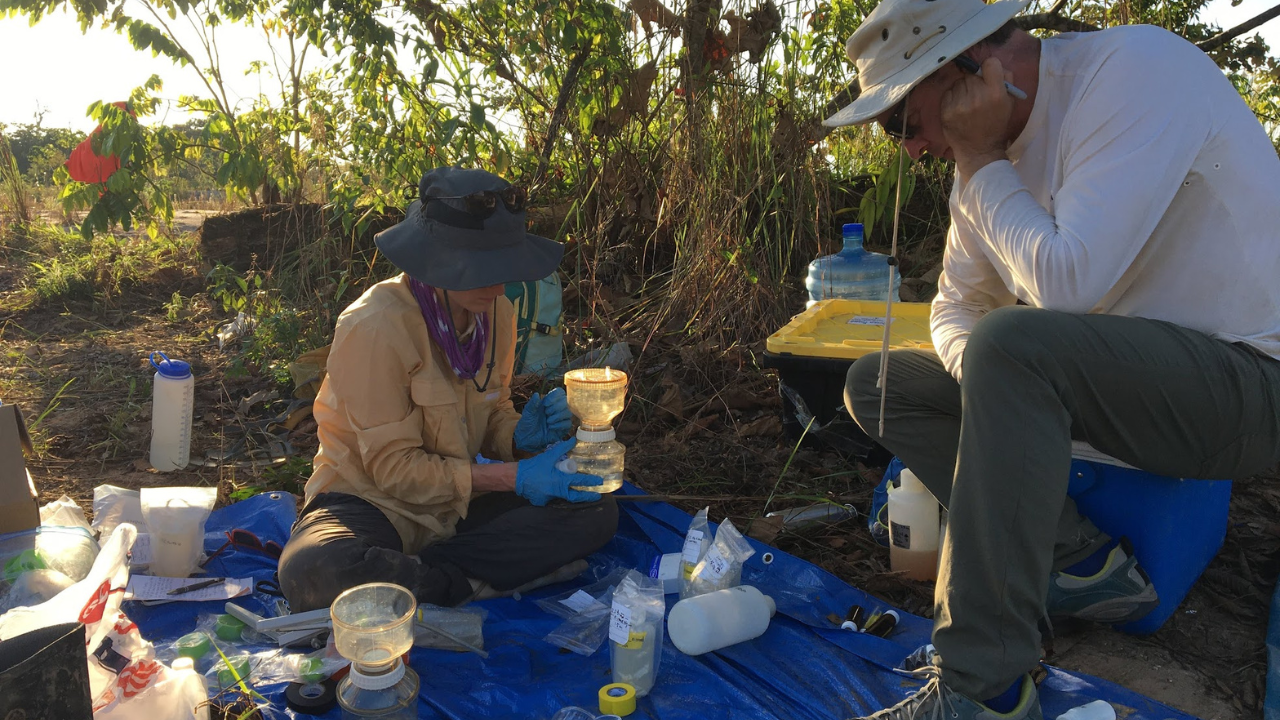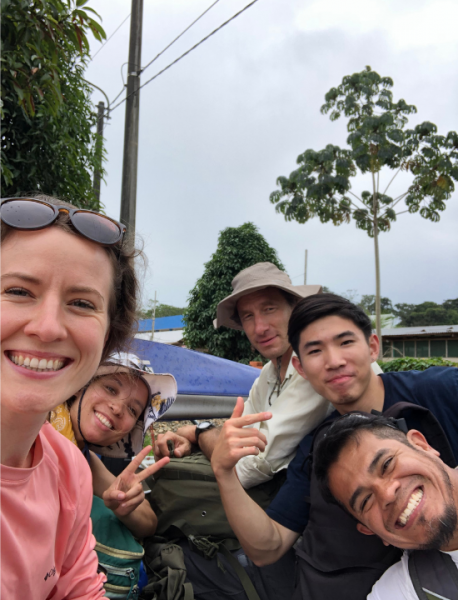Sampling from the Middle
Miranda Volborth
CEE PhD student Shannon Plunkett finds the most valuable tool in designing mercury studies in the Amazon to be a long-held—and expanding—Duke network

When Shannon Plunkett came across a news release from National Geographic detailing plans to research mining ponds in the Peruvian Amazon, the first-year Duke CEE PhD student headed straight to her computer to email the expedition’s principal investigators.
“I introduced the work I was doing and my proposed timeline, and asked if they would like to set up a time to talk,” said Plunkett. “I wanted to go, too.”

At the University of Wisconsin-Madison, Plunkett had double majored in Spanish and geography, but was interested in working at the intersection of human and environmental health. “After school I had the opportunity to work on a project on lead contamination of urban gardens that were primarily maintained by Latino communities,” said Plunkett. “They needed a Spanish-speaking gardener interested in this intersection, and it was the coolest project I could imagine.”
Plunkett continued the line of inquiry as she worked toward a master’s degree in soil science, also at the University of Wisconsin-Madison. A research fellowship with the U.S. Environmental Protection Agency followed, where Plunkett gained a deeper understanding of remediating soil contaminated by lead and arsenic. But there was still a whole world of environmental health topics that she felt she hadn’t really explored.
“I wanted to be a better scientist, so I went for my PhD,” said Plunkett. “My main criteria were that I could learn about a metal that was new to me and use Spanish again.”
As she was researching potential PhD programs, Plunkett discovered Duke professor of civil and environmental engineering Heileen Hsu-Kim. With her long-time collaborator Bill Pan, associate professor of global environmental health in the Nicholas School of the Environment and Duke Global Health Institute, Hsu-Kim has been investigating the extent of mercury contamination in Madre de Dios, Peru, due to small-scale, or “artisanal” gold mining.
To extract gold there, rainforest is clear cut and the land excavated. Miners add elemental mercury to ore to form an amalgam. That’s churned into a slurry and the untreated mercury-contaminated residuals are discarded. The gold that’s left is burned to vaporize any remaining mercury, which then settles into nearby waters. The microbiota in those environments then get to work converting that inorganic mercury into methyl mercury— an especially neurotoxic type of mercury, which bioaccumulates in fish and the animals that eat the fish.
When Plunkett read about Hsu-Kim’s work, she felt that she had struck gold herself. It was the nexus of every topic of importance to her.
She was delighted to be accepted into Hsu-Kim’s lab. The feeling was compounded when, the day after she emailed them, the researchers with National Geographic wrote back and said yes, she could come along on their expedition.
That’s how Plunkett found herself on a canoe in the middle of the Peruvian Amazon, shuttling eight bags of her own lab equipment and chemicals to a spot deep inside the rainforest, over a kilometer away from the river.
.png)
“Working in the Peruvian Amazon is the pinnacle of extremely difficult logistics for fieldwork.”
Duke CEE PhD student Shannon Plunkett
The supplies were necessary because working with mercury generally requires refrigeration, and Plunkett was very, very far off the grid. To make their way to their first field site the group traveled first by van, then all-terrain carguerro, then canoe, then another ATV—the journey took a whole day. Absent refrigeration, Plunkett had to bring her own chemicals along to stabilize the samples, an effort that was complicated by international regulations that differed from chemical to chemical, and country to country. “Working in the Peruvian Amazon is the pinnacle of extremely difficult logistics for fieldwork,” said Plunkett.
But these kinds of trips have yielded invaluable data about the human and environmental health effects of small-scale gold mining, which has been deeply entrenched in Peru for the last 30 years. Across the border, in the Ecuadorian Amazon, miners have panned for gold for decades. But more intensive practices, like bulldozing the land, are rapidly expanding. Pan and Hsu-Kim have established a collaboration with colleagues at the University of San Francisco – Quito, giving Duke researchers—including Plunkett—the unique opportunity to gather water quality and exposure data at the outset. This data will be valuable to communities that rely on the river and could act as a baseline if the condition of the river degrades due to the new mining activity.
So, not too long after she returned from her first expedition, she began planning another, to Portovelo Zaruma, the major gold ore processing center in Ecuador.

“They receive ore from all over the country, grind it up, and add cyanide and mercury to it. The wastes are temporarily stored in ponds but ultimately discharged into the river, largely untreated. The river flows 150 kilometers downstream and crosses the border into Tumbes, Peru, where it is the only irrigation source for the rice paddies there.” Rice paddies, said Plunkett, are extremely efficient at converting inorganic mercury to methyl mercury, and right as the rice grain matures, the plant makes a big push to shift almost all of the methyl mercury into its grains of rice. “So people eat the most mercury-enriched part of the crop,” Plunkett explained. “And in this area of the world it’s common to eat rice three times a day.”
And that is how Plunkett found herself, once again, planning an unorthodox research trip—this one a reconnaissance mission, to figure out how best to design a future study assessing the downstream effects of Ecuadorean gold processing on contaminant loads in the water and in the crops irrigated by the water.
“There’s a lot of freedom in a reconnaissance. I’m not going in with the mindset that I have to collect everything right now.”

“There’s a lot of freedom in a reconnaissance,” she said. “I’m not going in with the mindset that I have to collect everything right now—I’m really looking for some indication that the hypothesis about mercury and rice is substantiated, and to imagine what a broader expedition would look like.”
The knowledge of local field partners— people who travel the area with researchers and facilitate meeting people and collecting information that cannot be gleaned from aerial photos alone— is critical to the success of research like Plunkett’s. In Peru, her field partner from the Universidad Nacional de Tumbes shared a wealth of knowledge about how the water moves through the landscape—knowledge that informed an efficient sampling scheme to assess how contaminants may also move across the land.
“Our Duke network is critical to our understanding of how to operate effectively in the region, from the Peruvian Amazon to the Ecuadorian Amazon, Southern Ecuador, and Tumbes.”
She’ll also figure out how best to collect rice and soil samples and return with them to Hsu-Kim’s lab at Duke, where they’ll be analyzed. “Our ability to measure total and methylmercury in different environmental media is unique,” said Plunkett. “There are very few labs with comparable capability anywhere.”
Ultimately, the hope is to return to the local partners something of great value: data about their communities’ exposure levels.
“I couldn’t do this work on my own,” said Plunkett. “Our Duke network is critical to our understanding of how to operate effectively in the region, from the Peruvian Amazon to the Ecuadorian Amazon, Southern Ecuador, and Tumbes. The logistics make it really challenging, but I would not want to do anything else besides this.”
